1001 Comics:
You Must Read Before You Die
From Monday 3 October, you will be able to buy copies of my new book, 1001 Comics You Must Read Before You Die, in UK shops and online (US release date is 25 October). An online database of the 1001 Comics is being developed on this website, with the basic listing of titles, creators and publishers which will be gradually supplemented with additional information, updateds and images not found in this essential book.
To give you a bit of background on this book, here are three interviews I’ve given recently with Comic Heroes, Broken Frontier and Bleeding Cool. I look forward to hearing your comments on 1001 Comics, your reactions to what we selected and your suggestions for what we should have included. Because, as we all know, even 1001 is not enough to encompass all the worldwide wonders of this medium!
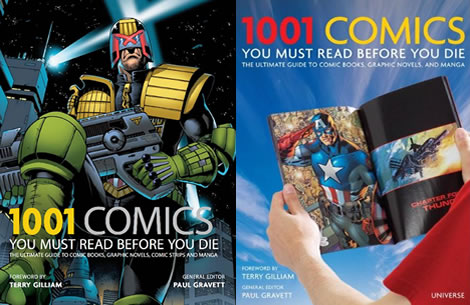
1001 Comics: Covers to the UK (left) and US (right) editions.
INTERVIEW: COMIC HEROES MAGAZINE #8
Conducted by Jes Bickham
You’ve written books on comics before of course, but how did this project get off the ground? Were you approached or did you lobby for the book?
Paul Gravett:
This whole insane project came my way courtesy of my pal Matt Madden, American comic artist and author of 99 Exercises In Style, in which he brilliantly demonstrates 99 different ways to convey the same simple one-page story in comics. Madden was offered the job of General Editor, but had too much on his plate teaching comics and co-creating his next How To textbook with his wife Jessica Abel, so he suggested me. I really wasn’t sure at first. It’s a mind-boggling task, but the more I thought about it, the more excited I became about trying to do it.
Be honest now: You are a vastly knowledgeable chap and a noted comics historian, but had you read all 1001 comics in the book? And by extension, did any of the shortlisted books surprise you?
To be honest, no, I haven’t read every single comic in 1001 Comics You Must Read Before You Die. I’m almost afraid that if I did, I might die! No, don’t worry, there’s no curse attached to this 960-page brick of a book, but I’m not sure that anybody has yet read them all. For a start, a fair few have not been translated into English, at least not yet. In the selection process I did get to see lots of amazing samples and extracts and learnt a lot about amazing comics I had never come across before. I was determined to look for the best outside of the usual territories and wherever they might come from. I’m especially pleased that we’ve managed to include world-class examples from Poland, India, Kenya, the Philippines, Indonesia, Cuba, Brazil, Algeria, Mexico and Egypt. These were among the most surprising and fascinating choices that prove masterpieces can also come from anywhere.
What was the selection criteria for featured books?
What makes any comic a truly great comic? Quality of art and story, innovation, influence, impact, originality, provocation, experimentation, were all part of the blend of criteria. I recruited 67 international connoisseurs and co-writers onto my Team 1001, so I could count on their personal tastes and insights to help me hone the final 1001 down from a long, long shortlist of nearly twice as many candidates. With their feedback, I was tinkering with the list right down to the last moment, so we could squeeze in some remarkable comics coming out later this year, like Craig Thompson’s massive Habibi. The whole process was a really complex balancing act, between different genres of comics, between different countries, acknowledging the undeniable importance of American comics, French and Belgian bandes dessinées, and of course Japanese manga, but seeking out the very best from loads of other cultures. Also balancing how many entries went to key creators, like Osamu Tezuka or Alan Moore, and having to make some tough choices out of their output. With nearly two centuries to choose from (the very first entry is by Genevan pioneer Rodolphe Töpffer) and spanning everything from a short 6-8 page story to serials hundreds, even thousands of pages long, the field to choose from was vast.
Is the digital world of comics represented and if so how?
Yes, definitely, there’s no way to ignore webcomics, they are revolutionising the medium all over again, allowing anyone to self-publish their work unfettered by editorial tampering and reach a worldwide readership. So a fair few of the 21st century choices here started out online and have only made it into print afterwards.
Can you tell us some of your own personal favourite books that made the cut?
I’m glad we got in gems like Steve Ditko’s Warren horror stories, Mother Delilah from Boys’ Ranch by Simon and Kirby, Sanpei Shirato’s original Kamui-den manga and Italian detective Commissario Spada by Gonani & De Luca, but that’s only four or 0.4 per cent. There is so much great stuff included here, it makes me dizzy!
How did Terry Gilliam get involved in writing the introduction?
I’d met Terry Gilliam in the past and knew he was passionate about comics, having worked with the great MAD inventor Harvey Kurtzman on his Help! magazine in the early Sixties, where Gilliam crossed paths with future Python cohort John Cleese, and making his own in CARtoons in the States and Pilote in France. Luckily, Gilliam had just completed his stunning operatic production of Faust and had time to pen a very funny and frank introduction about how MAD comic books corrupted him as a kid and made him who he is.
What are you proudest of with 1001 Comics You Must Read Before You Die?
There have been other guides to 101, or maybe 500, but as far as I know nobody, at least in English, has ever compiled a guide to 1001 comics that is as expansive, inclusive and informative (nearly 300,000 words!) as this. This was truly a team effort, so I’m proudest of being able to call on such an array of knowledgeable panelologists and such a talented production team. without whom this book would not have been possible.
If you were to introduce somebody who had never read comics before, or considered them a viable form of both entertainment and art, to the form, what one book would you choose?
Tough to pick a single ‘one-size-fits-all’ book, as I’ve found talking to people that almost any comic, read at the right time and by the right person, can become their personal wake-up call. I guess Maus, Fun Home, Fires, V for Vendetta, Understanding Comics, Ghost World, Jimmy Corrigan, The Walking Man and The Arrival would be among my contenders from 1001 Comics.


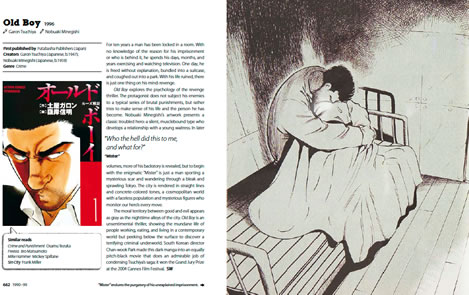
INTERVIEW: THE FRONTIERSMAN MAGAZINE #28
Conducted by Frederik Hautain
The hardest part, when doing 1001 Comics You Must Read Before You Die, is no doubt choosing the 1001 entries. How long did this process take, because there are bound to be some omissions, and some inclusions that people might find surprising too…
Paul Gravett:
You could say the selection process has taken my whole life, spent exploring comics past and present and as globally as I can. In real terms, it had to come together over a much shorter, high-pressure period and I relied on consulting with a range of writers around the world, 68 in all, for suggestions and feedback. I know there are plenty of amazing omissions, but in the interest of balance and diversity, I like the fact that there are many unexpected inclusions, in some cases comics that hardly anyone has written about in English before.
How much of a canon does the book intend to be?
I think it’s an attempt, yes. A canon is of course almost impossible to fix and tie down definitively, especially in a medium that is so international and in constant flux. But perhaps now, in this internet era, we can really build a broader international, transnational perspective on comics, get some grasp of the bigger picture. There’s still huge work to be done to unlock the treasures of under-explored comics cultures but this makes a start, at least by acknowledging Mexico, Brazil, Korea and others.
And in the same breath, how much of a ‘contemporary’ edition has the book become? Does it go as far back as the early days of 20th Century comics—material of which is available in libraries, in print in archive editions and what have you - or is the focus by far on what is readily available now?
1001 Comics does go as far back as 1837 and Rodolphe Töpffer. I thought it was important to include some of the 19th century geniuses and pioneers, like Doré, Busch, Frost, Opper, Outcault, Christophe, Caran d’Ache. As for the issue of current availability, I decided this should not be a criterion for inclusion, especially with quite a lot of older material being reprinted in recent years or made available again online. Another debate was about including comics that are not in English (yet). The American publishers preferred us to feature only comics that have been translated, but this would have meant excluding a vast wealth of top-class material. So we’ve been able to include some 10% or more and the good news is that more and more of these are already getting published, now or next year, in English. A whole database of the 1001 Comics is being built up on my website to supplement but not substitute for the book itself, of course! Here we’ll update details of available editions, links and translations, and provide errata, feedback, and extra cover images and extracts which we couldn’t squeeze into the book’s 960 pages.
We just mentioned ‘availability in print’, but does the book also feature any webcomics?
Yes, quite a few 21st century entries originated as webcomics, even if they have subsequently been published with ink and paper. It would be impossible to ignore webcomics and assemble a list like this that truly attempts to be up-to-date and of the moment.
Were does one find the proper balance between the various comics industries? The most important ones (US/UK, France/Belgium/Italy and Japan) will be well represented. But then again, a 1001 list that originated in Japan or the European mainland would have looked quite different…
Quite right, nationalistic biases are almost inevitable doing this kind of project. I’d love to see other 1001 lists from other countries and discover what wonders we’ve missed in this one. There’s clearly more than enough to do 1001 Manga and 1001 Bandes Dessinées, for starter. It’s fair to say that the the US, France/Belgium and Japan do have the lion’s share of this list, and some may feel I’ve included a few more British creations than others might have chosen, but I think it’s reasonably balanced and tries to acknowledge quality of art and story, originality, innovation, influence, cultural impact and experimentation. It’s no big secret that almost all of these 1001 Before You Die lists are often subtly altered when the books appear in other languages, because replacing text-only entries is quite easy. The French edition is coming out from Flammarion for the Paris Salon du Livre in 2012 and may well be modified to suit their readership more specifically. A Japanese edition is also planned, I think, and other languages will follow.
What are some of the notable entries coming from outside the traditional English and European comic markets?
Gosh, where do I begin? I’m pleased we have an early Korean fantasy hero by the great Sanho Kim, who I met in 2009 at the Bucheon International Comics Festival in Korea, when they opened an astounding new “cathedral” to comics or manhwa, on a scale that makes even Angoulême look modest. Now Kim is probably best known in the West for his work at Charlton Comics. I wish we could have featured more ‘komiks’ from the Philippines but Gerry Alanguilan selected El Indio by Francis Coching, the founding father of their national adventure comics tradition. Ernesto Priego picked some Mexican historietas, and one of my favourites of these is Los Supersabios, a big influence on Jaime and Gilbert Hernandez, wonderful, exuberant storytelling. And I am pleased to include “art” comics from beyond the usual channels, such as Charlotte Salomon’s painted autobiography, Leben oder Theater? or Max Ernst’s Semaine de Bonté, for instance. All of these are not mere “obscura” or “weird sh*t”, to my mind, but valid, exciting aspects of sequential art waiting to be more fully appreciated.
Are the entries in the book classified chronologically, by region or genre?
To make this work easy to adapt from language to language, we had to order them by the order of their date of first publication in their original language. So the book also works as a year-by-year timeline of how this medium has changed. It throws together some surprising synchronicities along the way.
Such as?
For example, I liked seeing Max Ernst’s Semaine de Bonté, E.O. Plauen’s Vater und Sohn from Germany and the first robot manga Tanku Tankuro by Gajo Sakamoto all showing up in 1934 amongst the start of great American strips like Terry and the Pirates, Flash Gordon and Li’l Abner. What a year!
You edited and put together the book, but didn’t write it on your own. What’s the comics background of the people that contributed?
One reason Matt Madden recommended me for this insane assignment, after he found he was too busy to shoulder it himself, was my international network of perceptive connoisseurs, collectors and critics of comics from 27 countries which I have developed over thirty years. These were people I knew I could rely on to bring insights, depth and breadth of knowledge, and some welcome surprises to honing this list into something bold and mind-expanding. It was also important not to have this book be very ‘blokey’ and written entirely by men, so I’m pleased that 21 of the reviewers, around one third, are women.
What information were you looking for to include in each entry?
We give the date of first original or complete publication, the dates and nationaliy for every creator, the original publisher and their country of origin, and one or more genres. Depending on space, we sometimes can add info on awards, influences or adaptations, as well as adding a list of other works by the same creator(s) or related ‘similar reads’. Then you get the main meat of the review, about 250-300 words. It’s a challenge but you can convey quite a lot within that wordcount.
Do you also go so far as zooming in on must-read story arcs? Like, if you have an entry that says X-Men or Tintin’, do you also highlight the most notable releases?
Yes, in several cases. Tintin, as a case in point, could not be satisfactorily covered in just one overall entry, so between us we narrowed in on a few of the most significant albums. As for the ongoing X-Men or Batman series, we finally chose key periods or story-arcs in the main.
Is the Judge Dredd cover that has made its way around the web the one intended for the UK market, and will the US and translated editions feature other covers? Or was putting Judge Dredd on there your teenie bit of British chauvinism? [Laughs]
Dredd is for the UK edition. Every region/language will have a cover of their own. The US cover is totally different, photographic, blue-sky background, with someone reading a Captain America comic book. Lots of factors dictate the cover, including the trickiness of getting and affording permission to use major iconic properties like Batman or Spider-Man. The back cover of the UK edition features a cover detail from Charles Burns’ Black Hole, so that gives a bit of a contrast and balance.
Listing 1001 Comics is not the same as listing the top creators of all time. Yet, I’m sure people can deduct a list of the most dominant talents based on how many times the work of certain people is featured?
Dominant if not prolific, yes, this does give some indication. Personally, I am not that keen on hierarchies or ‘Top Tens’, insisting that one creator or book is superior to another, so I’m glad 1001 Comics does not prioritise between all these vastly different but equally fascinating comics. You can read them in any order!
You’ve been reporting on and researching comics for about three decades now, and you’re very much regarded as an authority in the field. All that taken into account, did you discover any works that have become personal favorites?
I mentioned Los Supersabios already. From former Yugoslavia, Zika Tamburic turned me on to their founding father, Andrija Maurovic, whose work I’d seen glimpses of, but seeing the fuller range, I was really impressed. Finally being able to read (in French) Shirato Sanpei’s original, Garo-era Kamui-den was also a revelation. I’d never heard of Joe Brainard’s C Comics, a wild, pioneering Sixties mash-up between comics and modern poetry, a whole other branch of the medium. And thanks to Fantagraphics translating, at last, albums by Tillieux and Macherot, we’ve of course included them both, BD masters whom I’d known about before but have belatedly come to admire and enjoy. As vital as the past is of course, the 1001 Comics list is weighted, finally though, towards the last 25 years or so, which takes up most of the second half of the book. I think that emphasis on the recent is not surprising, as we’re living through such a creatively fulfilling era for graphic novels, translated world comics, a ‘Golden Age’ I could only dream about when I was growing up. I decided to dedicate 1001 Comics to Maurice Horn, the great American expert, who compiled the World Encyclopedia of Comics in 1976. I read that book from cover to cover, it was like The Bible to me, giving me glimpses of a panoply of comics of a scale and variety I had never imagined. It changed and shaped my life and gave me a passion that shows no signs of dimming. I dare to hope that maybe 1001 Comics might have some of that effect too.
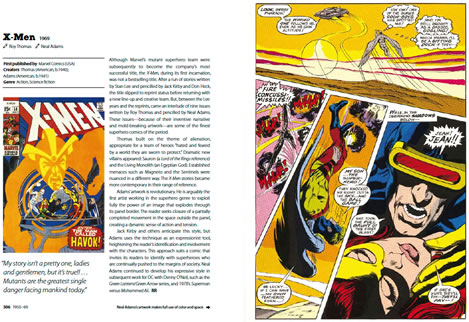

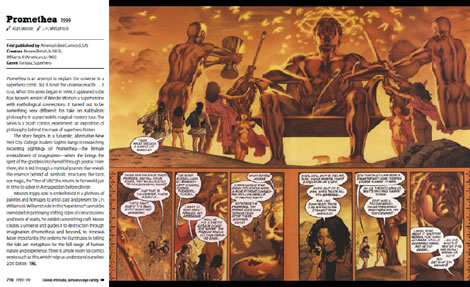
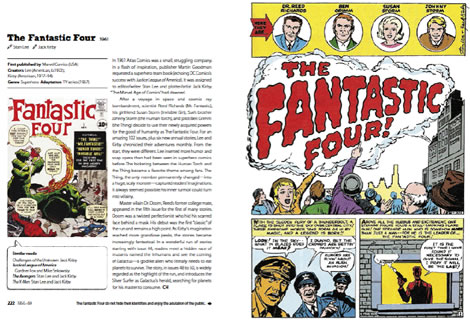
INTERVIEW: BLEEDING COOL
Conducted by Rich Johnston
Top lists generally go up to 10, ambitious ones to 100. 1001? Why did you decide you needed to do ten times as much work as anyone would have reasonably expected?
Paul Gravett:
Firstly, because 1001 Comics You Must Read Before You Die is part of the best-selling international 1001 series you see everywhere, that covers movies, books, even golf courses. Secondly, because it sounds snappy like the Arabian Nights. But mostly because 100, even the 150 I chose for my 2005 book Graphic Novels: Stories to Change Your Life, just isn’t enough to do justice to the amount of amazing comics created around the world. In fact, even 1001 isn’t enough, it turns out! This is the first 1001 Comics that I am aware of that really tries to be international and exploratory. Last year, Tony Isabella on his own produced 1000 Comic Books You Must Read, which I’ve seen and looked very good, if rather US-centric and light on info or commentary. But I’ve got the blow the trumpet here, sorry, because this furshlugginer 1001 Comics volume is the same price, but clocks in at over three times the page count and over 300,000 words.
How do you even go about creating such a list in the first place, let alone finding the publisher?
The publisher came to me via my pal Matt Madden, author of 99 Exercises In Style, who was offered the project but was too busy and thought I’d be perfect and kindly suggested me. The whole shebang was proposed back in 2009 but was delayed by the banking crisis and recession panicking international co-publishers. It was only last July 2010 that they got back in touch and we finally got the green light in September so it’s been a slightly insane, intense production.
Before creating the 1001 list, as editor I began to recruit my Team 1001 by contacting knowledgeable connoisseurs all over the world, not just to write entries but for their advice and feedback as we all built up the list. In the end, I involved 67 different co-writers from 27 different countries including the USA, Canada, Japan, Korea, Norway, Poland, Argentina, Brazil, India and the Philippines. And I was determined not to have it overwhelmingly written by men, so I’m pleased that fourteen of the writers are women. As for the list itself, I can almost guarantee you that you will not find all of your all-time favourites here, but I can equally guarantee that you will discover some fantastic brand-new favourites. I know I have!
Do you feel you had to focus the spread of the books based on the likely audience? A concentration of books written in English, say, or titles more likely to be recent and in print?
Initially, the American publishers tried to insist that every one of 1001 Comics must be available in English. But I had to insist that this would exclude loads of absolute masterpieces, and it wouldn’t make the book work in the other languages it is going to appear in, such as French or German. So somewhere around 12 per cent or so of the 1001 are not available in English, at least not yet. I seriously hope that exposure in 1001 will alert publishers and motivate them to translate them. And for anyone kvetching about all these untranslated entries, I’ll be keeping a constant update on what titles do get translated (I heard of two more only this week coming up soon) and I’ll be adding sample extracts with translations on my website so you can get a flavour of them.
As the list grew, one of my wonderful French Team 1001 members supplied a list of over 700 French-language comics for the book and we had to explain that this was going to rather imbalance the whole thing! The list formed organically from my initial few hundred and I can assure it was being tweaked right to the very, very last moment. We must have considered several thousand suggestions. There were plenty of agonising decisions and omissions, even with as many as 1001. But then that just goes to show what an abundance of top-class, diverse, exciting comics are out there.
We did have to arrive at some sort of balance between countries, of course, with the USA, Japan and France/Belgium inevitably the most represented, but forty countries included in total, so it’s been quite a balancing act. Fortunately, we also provide some additional sidebars of Similar Reads or Also By to direct readers to more great stuff, and there will be more of these extras on my website.
One criterion we considered is whether a comic was in print or not but this was never decisive. The main criteria were significance, innovation, originality, influence, impact and quality. For our start date, we decided to go back into the 19th century and present at least a few of the fascinating pioneering works of printed comics, kicking off with Rodolphe Töpffer from Switzerland. As for an end date, we come right up to date with hot new titles from 2011, some not even published yet! I should explain here that the book is organised not by country or genre but chronologically by the year of first publication in the original language. This is because if we’d tried it alphabetically, it wouldn’t also work in other languages, because titles and character names are different. The result is a really intriguing year-by-year chronology - as well as one of first truly global attempts at proposing a World Canon of Comics.
Have you addressed the issue of digital-only comics, or have you remained wedding to print?
Webcomics do feature in the latter years of the book, yes, because that is where plenty of first-rate innovative comics now originate. Of course, the whole digital comics field is only going to expand, but I’m glad we’ve acknowledged some of the good stuff already out there.
Are they entries that you think will surprise people? I mean even his detractors wouldn’t be surprised to see Dave Sim’s Cerebus in there… but they may be by Rob Liefeld’s X-Force. Is there anything given a serious criticical reinterpretation for this volume?
I had to be persuaded by a couple of Team 1001 members on certain choices, like Bendis & Bagley’s Ultimate Spider-Man: Clone Saga. I’d heard such bad reports about the original version that I’d never read it, but in the end B&B’s take made it in there, and rightly so. I’m also glad a couple of British girls’ comics got included like Patty’s World and Belle At The Bar, because they tend to be forgotten, but re-reading them they stand up as compelling soap operas and social chronicles. There are quite a few works that I had never heard of before in this book (and I have read way too many comics in my lifetime, believe me), so it’s a buzz to spotlight them and bring them some attention. Liefeld fans, though, may be disappointed.
You describe 1001 comics to read before you die. But what about after that? Are there any comics you’d specifically recommend for the afterlife?
Don’t worry, the book is not cursed and when you do read all 1001, you won’t keel over and die! I guess you could always adjust to the afterlife by catching up with Deadman, or Barnaby with his invisible Irish fairy godfather, or the eternal time-traveller El Eternauta, or NonNonBa by Shigeru Mizuki, a fantastic manga about yokai or ghosts and goblins, or Rob Hunter’s magical The New Ghost from Nobrow. Actually, in the afterlife you’d be able to enjoy all those Fantasy Comics collaborations of Dead Comics Creators, like Herriman and Tove Jansson, Tezuka and Kirby, or George McManus and Hergé!
Also what are the odds that the weight of this thing will actually kill someone before they’ve had a chance to try to read one of the comics described inside?
Ignatz the Mouse would definitely use 1001 Comics as a perfect brick to bean Krazy Kat, that’s for sure. It’s a massive tome of 960 pages and before you ask, yes it’s 960 pages, not 1001 pages, because not every entry gets an illustration. Which, I can assure you, has been pretty frustrating! In an ideal world, every single one would have an image. Once again, my fab website will come to the rescue and loads of unillustrated entries will get pictures online. That said, you’re going to have to buy the printed book because only there can you read all the brilliant insightful, fact-packed entries, and get a lethal murder weapon as well.
You’ve been described as The Man At The Crossroads by Eddie Campbell. Are there any titles included that you’d consider yourself in some way responsible for their existence?
Not ‘responsible for’, no. Like most of us, I wrote and drew my own comics as a kid, but I’ve had no ambition to create them since. But it feels good to see how some creators whom Peter Stanbury and I helped to promote in Escape Magazine in the Eighties have gone on to produce real masterpieces by the likes of Eddie, Neil Gaiman and Dave McKean, Chester Brown, Chris Reynolds, Carol Swain, Ed Pinsent and others. These are astonishing times for comics worldwide right now and 1001 Comics reflects that, because nearly half of the book covers comics from 1990 to today. Manga, the internet, the rise of women creators, the graphic novel, autobiography and ‘comics journalism’, these and other factors have heralded a true Golden Age, which I can see only shining brighter and brighter in the years ahead. As for what is in the 1001 list, the plan I think is to gradually announce what’s made it in over the coming months before the book is released in October from Cassell in the UK and Universe in the States. The French edition, which the much less urgent, less death-themed title of 1001 Comics To Read in Your Life, is coming out next Spring from Flammarion. The UK launch will be a Comica Festival event in London with some big guests and fun surprises!
Posted: October 1, 2011











